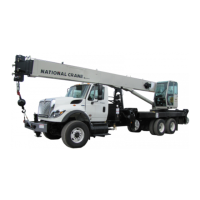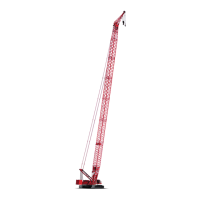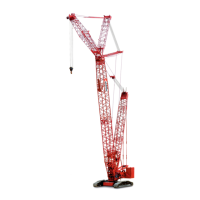Manitowoc Published 09-10-14, Control # 065-24 4-3
14000 SERVICE MANUAL BOOM
Adjustment
See Figure 4-2 for the following procedure.
The following instructions assume that the Rated Capacity
Indicator/Limiter (RCL) is installed and properly calibrated.
During the following procedure, boom angle is monitored on
the working screen of the RCL and on a digital protractor-
level.
The automatic boom stop was set at the factory and should
not require periodic adjustment. Adjustment is necessary
when:
• Parts are replaced.
• Luffing jib is installed or removed.
1. Park the crane on a firm level surface or level the crane
by blocking under crawlers.
2. Make sure proper adjusting rod is installed:
• Rod (2a) for boom WITHOUT LUFFING JIB.
• Rod (2b) for boom WITH LUFFING JIB.
3. Boom up slowly while monitoring boom angle on RCL
working screen.
4. Stop booming up when boom reaches specified Angle A
(Figure 4-1
).
Verify boom angle with an accurate digital protractor-
level (3, View C) held on centerline of boom butt. Angle
on protractor-level should be within 1° of angle on RCL
working screen. If not, calibrate RCL.
• If the boom stops at specified angle, further
adjustment is not needed.
• If boom stops before reaching specified angle, go to
step 5.
• If boom reaches specified angle before it stops, go
to step 6.
5. If the boom stops before reaching specified angle:
a. Loosen jam nut (4, View B).
b. Turn adjusting rod (2a or 2b) all the way into
coupling (5).
c. Boom up slowly until the boom reaches specified
angle.
d. Turn adjusting rod (2a or 2b) out against the boom
butt (1) until limit switch (6) “clicks” open. On Past
Production, the LED on the limit switch should go
OFF (View A).
e. Tighten jam nut (4).
6. If the boom reaches specified angle before it stops:
a. Loosen jam nut (4, View B).
b. Turn adjusting rod (2a or 2b) out against the boom
butt (1) until limit switch (6) “clicks” open. On Past
Production, the LED on the limit switch should go
OFF (View A).
c. Tighten jam nut (4).
7. Check that actuator rod (12) over-travels limit switch as
shown in View A.
8. Boom down and then back up. Boom must stop at
specified angle. If the boom fails to stop, repeat
steps 3 through 7.
Actuator Rod Replacement
See Figure 4-2, View B for the following procedure.
1. Remove damaged actuator rod (12).
2. Slide spring washers (8 and 10) and spring (9) over new
actuator rod while sliding new actuator rod into bracket
assembly.
3. Position actuator rod (12) so tapered end just touches
limit switch (6) roller (View B). Actuator rod must not
depress limit switch roller.
4. Drill 1/4 in (6,35 mm) hole through spring washer (10)
and actuator rod (12).
5. Install dowel pin (11).
6. Install proper adjusting rod (2a or 2b) and adjust as
needed for correct maximum angle.

